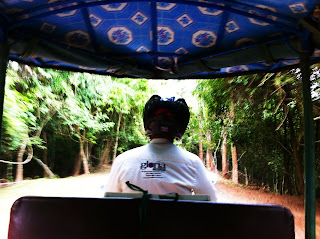There are very few places on earth where evidence of genocide is so well-preserved as they are at the
Choeung Ek Killing Fields and the
Tuol Sleng S-21 Prison in Cambodia.
 |
The Killing Fields. Buddhist prayer
bracelets left on bamboo fence
surrounding a women and children's
mass grave. The Killing Tree in
the background. |
This isn't some morbid fascination in visiting haunted places with tortured souls. In fact, we were hesitant about going at all because we didn't know if we could handle the information. However, they have been preserved to reveal the horrific story of the Khmer Rouge past to the world with hopes of never repeating this dark history again.
Prior to our arrival in Cambodia, we did a lot of reading on the Khmer Rouge and the genocide that killed approximately 2 million or 25% of the country's population from 1975 to 1979. One of the most poignant books was the autobiography, Surviving the Killing Fields, by Dr. Haing S. Ngor. As a first-time actor, he actually won an Oscar for best-supporting actor for his role as Dith Pran in the movie, The Killing Fields.
 |
Dr. Haing S. Ngor's
autobiography. |
We encourage you to learn more about the crazed-paranoid leader, Pol Pot and his communist party who had a social engineering policy of exterminating any evidence of any culture, capitalism, and religion from the face of Cambodia in favor of a self-sufficient agrarian utopia. He succeeded in extermination but failed miserably in any sort of utopia. More like hell on earth is what they created.
Anyone that was a reminder of the former society (intellectuals, professionals, teachers, merchants, ethnic minorities, monks, even those wearing glasses because that indicated they could read and therefore, educated, etc.) were killed. Those suspected of spying for the CIA (they'd never even heard of the CIA, but that didn't matter) were tortured, forced to falsely confess names of friends and family who were "also CIA spies", and summarily executed. The worst torture was reserved for Khmer Rouge's own rank and file suspected of treason. Many also died from being worked to death in the rice fields, starvation, and disease.
A calculated, mass-murder of your own people is difficult to fathom. Yet, thanks to Khmer Rouge's own meticulous record-keeping and the lack of time in getting rid of the evidence when the Vietnamese liberation army drove them out, we were able to witness the remnants of this horror.




































